Meat complementary foods are the main source of protein and other useful substances that the child’s body needs for full development, building its own cells and tissues, enzymes, hormones, and antibody synthesis.
When is it time to introduce meat into a child’s diet? How to properly prepare meat puree for the first feeding, and which one is better to choose? How much meat should a child under one year of age and older eat? You will get answers to these and other questions by reading this article.
Why meat is good for children
- This is the main source of protein necessary for the body to fully grow and develop.
- Meat products contain large amounts of vitamin B, which is essential for the human nervous system.
- Meat contains amino acids that enter the body with food.
- High content of microelements such as iron, zinc, magnesium, cobalt, fluorine, phosphorus. Iron contained in meat is absorbed much faster than iron from plant products.
- The baby has already erupted his first teeth, and the fibrous structure of the meat contributes to the development of chewing skills.
From what months should a baby be given meat puree?
Up to 4-6 months, the baby eats only mother's milk or adapted formulas. The baby does not need any other products. After six months, nutrients become insufficient. The baby is gradually introduced to cereals, vegetables, and fruits. Only after adaptation to these products can you give your child meat.
Two months should pass after the introduction of the first complementary foods, and if the baby eats vegetable dishes with appetite and does not refuse cereals, it is time to introduce meat complementary foods.
Meat is an animal product, for the digestion of which the child’s digestive tract is subject to stress, so there is no need to rush with meat products.
Pediatricians advise introducing meat puree for the first complementary foods into the menu no earlier than 6-8 months. If you started feeding your baby vegetables and cereals at six months, at 8 months you can let your baby try meat for the first time. This rule is the same for both breastfed and bottle-fed children.
If a child is allergic and suffers from a lack of iron, there is a lack of weight or symptoms of rickets, meat can be introduced into his menu after 5 months only after consulting with a pediatrician. It must be homogenized rabbit or turkey meat, monocomponent.
Why you should not give meat to a baby under six months old
- At such an early age, the child’s digestive tract is not yet developed, some enzymes are not yet produced, and those that are produced are not active enough. Meat cannot be digested and rotting processes occur in the intestines due to excess protein.
- Excess protein also negatively affects the baby's kidneys.
- Before the age of 6 months, the risk of allergies is significantly higher.
When to introduce meat
Pediatricians do not have a consensus on this matter.
Some advise introducing meat puree no earlier than nine months of the baby’s life, while others already eat meat at six months of age. It all depends on the individual development of the baby’s digestive system and its characteristics.
Early complementary feeding with turkey meat is recommended if:
- the baby is not gaining weight well;
- the child has low globulin;
- The baby is in dire need of B vitamins.
If it is necessary to introduce meat early, it is better to use canned baby food: manufacturers maintain acceptable standards for fat content and sterility of preparation. Babies from 9-10 months can cook meat at home.
From the list of meat products allowed for infants, you can prepare a recipe from:
- beef;
- turkey meat;
- rabbit meat;
- veal
A chicken meat recipe is not suitable for infants due to possible allergic reactions to its components. Pork is very fatty, so it is advisable to cook pork dishes after two years. However, this recommendation from pediatricians is general: it all depends on the stability of the baby’s digestive system.
Meat puree, like vegetable mixtures, must be introduced gradually in small portions. First, offer the baby a coffee spoon of the product, then increase the portion, gradually increasing the volume to 60-70 grams. By the time your baby is one year old, you can prepare beef and turkey meat in the amount of 70-80 grams of daily servings.
What is the best meat puree for first feeding?
Meat produced in industrial conditions is better suited for a baby’s first introduction to meat products.
Meat puree from jars sold in stores is better processed, the membranes of muscle cells are destroyed by high pressure. Hemogenized meat (subject to high pressure) is easier for children to digest.
At home, no matter how long we cook the meat or beat it with a blender, the cell membranes remain intact, and the puree will still be fibrous. Digestion and absorption will be more difficult, so homemade meat puree is not the best option for starting meat feeding.
It is better to give such meat to a child after a year, but for now we have found out that the best meat puree for the first feeding is store-bought. You can choose such well-known companies as Fruto Nyaya, Grandma's Lukoshko, Agusha, Tema, Gerber, Hainz. According to ratings and reviews, these are the most purchased brands of baby food.
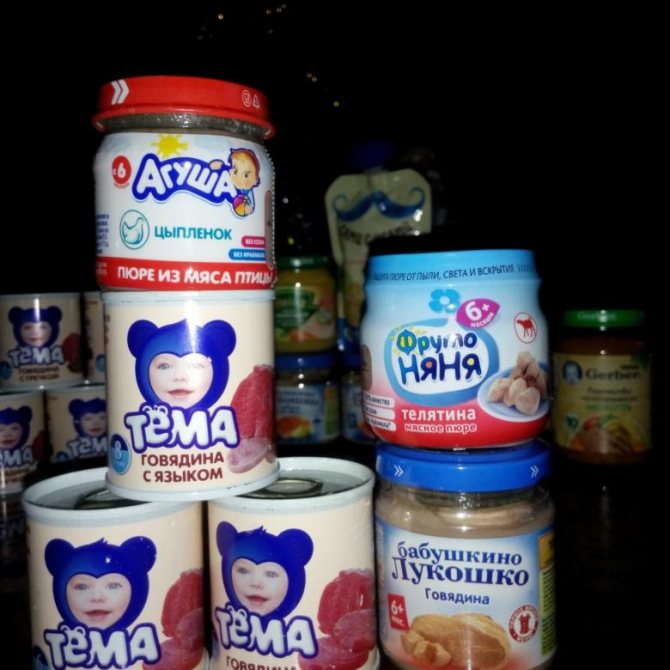
What is the best meat puree for babies?
Below we have compiled for you a rating of the most popular baby meat purees with a brief description.
"Agusha"
— this Russian company has long won the trust of mothers. Hypoallergenic baby meat puree for babies does not contain anything unnecessary, only useful substances. True, for viscosity, the manufacturer adds rice flour or starch, depending on the meat. The cost of a jar varies from 40 to 60 rubles.
Pros:
- Natural ingredients;
- Does not cause allergic reactions;
- Children eat with pleasure.
Minuses:
- Inconvenient to use metal can packaging;
- Liquid consistency.
Where to start with meat feeding
- The meat must be a homogeneous mass; for this, it is well boiled and thoroughly chopped using a blender.
- A child's first introduction to meat begins with 1/2 teaspoon.
- For the first time, meat, like any other new product, is given to the child in the first half of the day so that there is an opportunity to observe the reaction.
- Every day the portion increases. If the child was given half a teaspoon of meat the first time, the next day you can double the portion.
- Meat puree for first feeding, prepared at home, should not be stored in the refrigerator. The child should receive only freshly prepared foods, and if you do store them, then no more than a day.
- Meat is given to children for lunch.
- Over the age of 8 months, meat should be present in the child’s menu 5 days a week. When you don't give your baby meat, you can offer fish instead.
- After a year, you can cook meatballs so that your child develops chewing skills. But since at this age there are not yet enough teeth to chew fully, knead them with a fork.
- If your child refuses meat, mix it with a product that he enjoys eating. If this doesn't help, don't insist, wait a week and offer the meat again.
- There is no need to mix several types of meat. First, the baby must get used to each one separately.
When the baby gets used to the new taste, you can add meat to soup, vegetables and porridge.
Failure to follow the rules for introducing meat into complementary foods for infants can cause allergies or other health problems.
Daily intake of meat for children under one year old
The amount of meat he should receive per day depends on the child’s age.
| age(months) | norm(gr) |
| 7 | 5-30 |
| 8 | 50 |
| 9-12 | 60-70 |
What types of meat should I give my child?
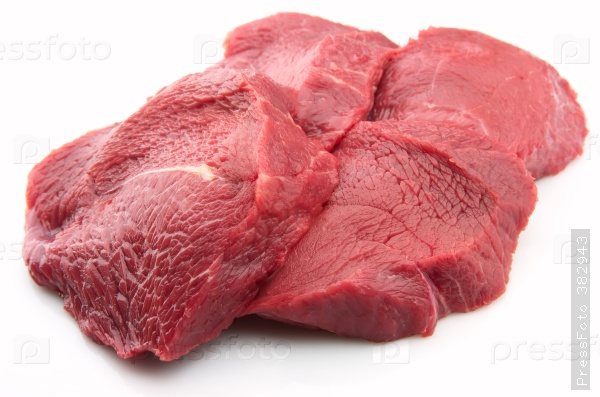
For the first acquaintance, turkey and rabbit are better suited. They do not cause allergies, are rich in proteins and minerals, and are also considered the easiest to digest.
Other types of meat are introduced a little later, using caution.
Chicken meat is a dietary product, rich in protein, but very allergenic. It is not recommended to start complementary feeding with chicken for children with allergies, especially if an allergy to chicken egg white is detected.
Beef and veal are considered the most difficult to digest, as they are very rich in animal protein, the digestion of which requires a large amount of time and enzymes. Children suffering from milk protein intolerance should not be given.
Horse meat is ideal for feeding children, it is rich in protein, contains a large number of useful elements, and does not cause allergies. The disadvantage is the high price and scarcity.
Duck and goose meat is not recommended for children under 3 years of age, as it contains refractory fats that the child’s stomach is not able to digest.
By-products are included in the child’s diet after ten months, when the baby is already accustomed to meat dishes. They are rich in iron, manganese and copper. It is allowed to give tongue, liver, hearts. Recommended for children with anemia.
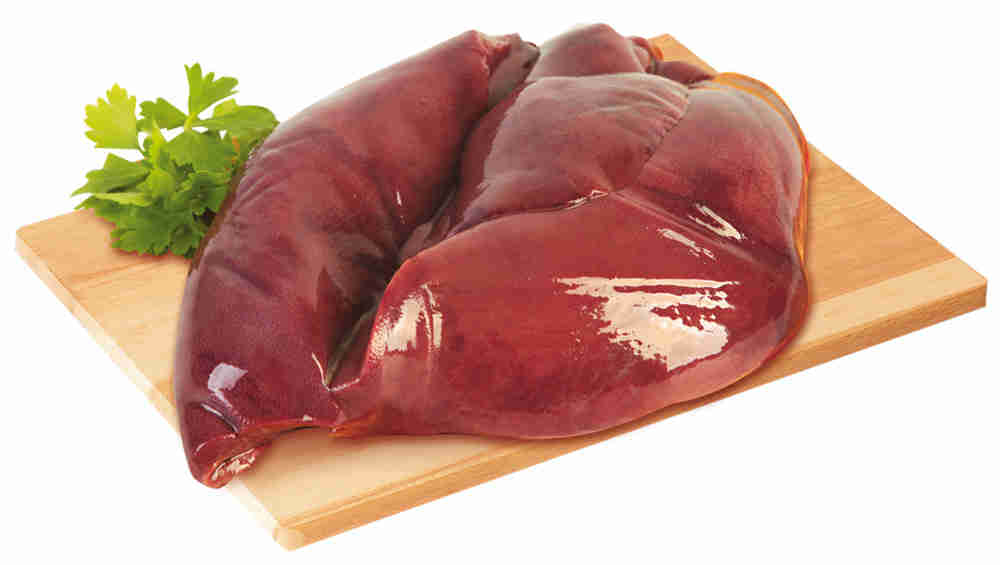
Liver is rich in iron and vitamin A, very useful for baby food, but the babies themselves don’t think so, they often don’t like the taste of liver.
To prepare liver puree for a child, boil it in second water, chop it, you can add any vegetables, boiled carrots are best.
Some experts have come to the conclusion that the child, while in the womb, has already become familiar with the meat dishes that she ate, and it is better if he eats the meat that is a priority in his family, unless, of course, the baby is allergic to it.
It’s best if you gradually introduce your child to all types of sources of animal protein, but there’s no need to rush into it. To begin with, the baby must get used to one type of meat, only then introduce him to another.
Composition of baby meat purees
It is very important to know that the most hypoallergenic types of meat are turkey, rabbit and horse meat, the puree of which is worth starting complementary feeding with.
If the child is not allergic to cow's milk protein, then after one month of the first meat feeding, you can introduce veal, beef, and then lean pork into the diet (but at first no more than 1 teaspoon per day).
The last to be introduced into complementary foods is chicken, as the most allergenic product.
However, in addition to meat, broth and purified drinking water, the puree may include the following components:
useful ingredients:
- sunflower oil - contains polyunsaturated fatty acids and vitamin E ;
- Rice flour is a hypoallergenic additive that promotes food digestion ;
- rice or corn starch is an easily digestible substance that gives the puree a delicate consistency ;
- vegetables - exclusively in jars marked: “No GMO” ;
- cereals - instant preparation , enriched with vitamins.
allowed products containing:

- natural rapeseed oil is a source of vitamin E and Omega-6 and Omega-3 fatty acids ;
- natural starch - contains healthy complex carbohydrates and fructose ;
- natural skim milk powder is a hypoallergenic supplement that replaces whole cow's milk , which sometimes manifests itself as an allergen;
- natural ascorbic or citric acids are a natural preservative, but be sure to count the amount, since the child should receive no more than 30 mg of these acids per day;
- sugar - under one year of age only in the form of fructose, lactose or unrefined;
- spices: bay leaf, parsley – no more than 1 g per day.
How to prepare meat puree for first feeding
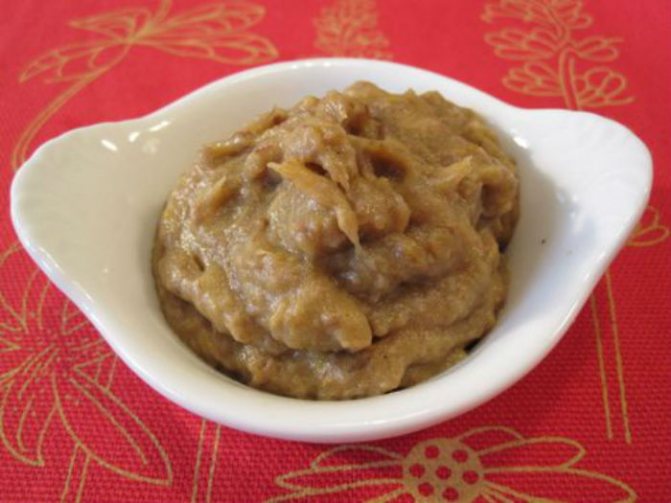
Meat puree recipe for complementary feeding
Making meat puree at home is not so difficult; to do this, you need to take 20-30 grams of lean meat, without fat and films, wash it, chop it finely or grind it in a meat grinder.
Cook for 30-40 minutes, then separate from the broth, add a little breast milk or formula, beat with a blender, or grind several times in a meat grinder and rub through a sieve.
Meat puree for baby's nutrition is ready; no need to salt it. Milk can be replaced with vegetable broth.
In this form, children receive their first meat food, in the form of puree, to which they are already accustomed when they became acquainted with vegetables and fruits.
At a later age, it will be possible to add salt to meat dishes, add herbs, bay leaves, a little butter or cream at the end of cooking, and also prepare meatballs, soufflés and steamed cutlets when the baby can chew on his own.
After a year, the baby can switch from homogenized puree to medium-ground dishes. The soups are prepared in vegetable broth, the meat is cooked separately and chopped, then combined with the broth, and the vegetables can be mashed with a fork.
Feeding with meat broth
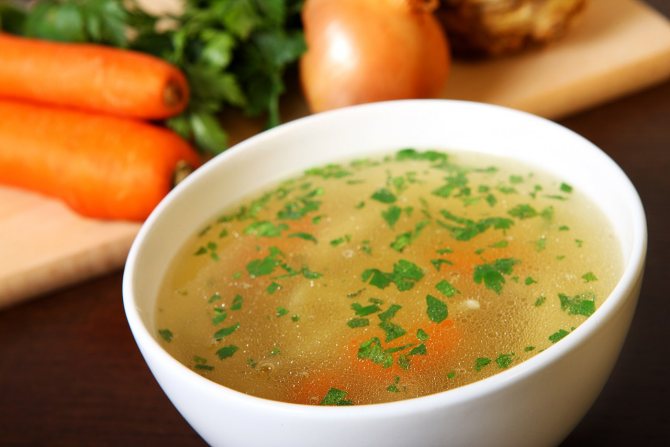
In the days of our grandmothers and mothers, it was believed that meat broth was very useful for a child; it was given to children starting from six months and only then was the baby introduced to meat.
Currently, doctors do not advise introducing meat broth into a child’s menu too early. Up to 8 months, the digestive tract does not work at full capacity, the walls of the stomach and intestines are very permeable, and the liver is not yet active enough to neutralize all the extractive substances that have entered the bloodstream from the broth.
It is better to postpone getting to know this dish until 1.5-2 years, but in the meantime you can prepare soup in vegetable broth with the addition of meat, cooked separately.
Possible harm
- Harmful substances boiled from meat remain in the broth, these are: cholesterol, taurine, creatinine, lactic acid, glucose, urea. All these substances have high chemical and biological activity and enrich the broth with flavor.
- If the meat has been treated with antibiotics or hormones, all harmful substances go into the broth during cooking.
- Consumption of meat broths at such an early age can result in excess uric acid; its crystals deposit in the kidneys and joints, and uric acid also increases allergic reactions.
- Broths stimulate blood flow to the mucous membranes of the gastrointestinal tract, they become irritated, which causes the production of gastric juice. This process is called hyperemia. Hyperemia makes the mucous membranes of the digestive tract vulnerable to allergens.
Benefit
- Due to the high content of extractive compounds, the broth is very tasty, which contributes to a good appetite.
- All beneficial compounds contained in meat end up in the broth when cooked.
- Broths promote increased secretion of gastric juice, thanks to which food is digested faster.
- Substances contained in broths are beneficial for the development of the nervous system.
Can meat harm a baby?
- An excess of meat products in a child’s diet puts a strain on the kidneys and negatively affects the digestive system.
- Some types of meat can cause allergies.
- Meat for feeding children must be boiled; in no case should children be given fried meat, smoked meats, sausages and other semi-finished meat products that are not intended for feeding a child.
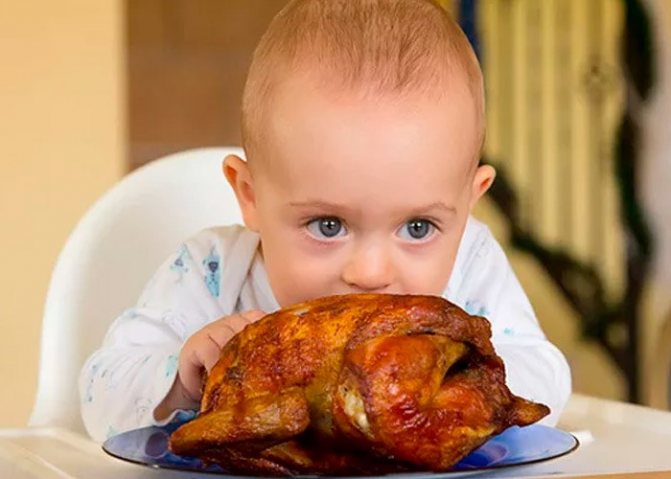
How to introduce meat puree into complementary foods?
The rules for introducing meat complementary foods are simple and similar to the general rules for introducing a new product into a baby’s diet.
- Make sure your child is healthy and active. Also note that he does not have rashes or allergies.
- For complementary feeding, you can prepare either a one-component puree (turkey, rabbit), or a mixture of meat and vegetables familiar to the child, to which he is not allergic.
- Avoid introducing a new product during a heatwave or after your baby has been vaccinated.
- Make sure that at least two weeks have passed since the previous complementary foods were introduced.
- Each time, cook a new piece of meat for the baby, and do not offer it left over from yesterday.
- It is better to feed your child home-cooked food, but you can also use high-quality canned food.
- It is better to give meat puree at lunch. This will allow you to monitor the baby’s reaction until the evening.
- The puree should be warm. It should be offered from a spoon.
Useful: How and when to eat bananas in the diet of a nursing mother
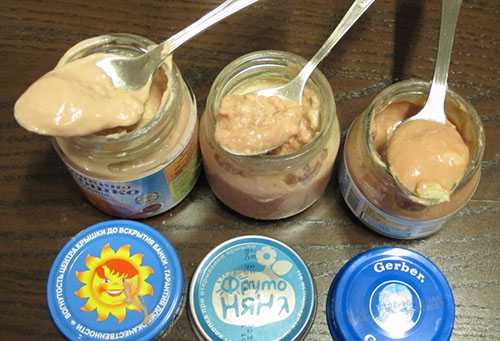
Allergy to meat
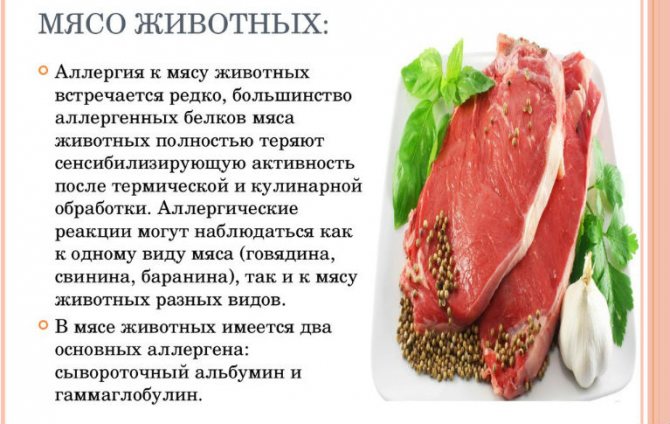
It is better to start the first meat feeding with rabbit and turkey. After the baby adapts to hypoallergenic varieties of meat, you can introduce him to beef, chicken and lean pork.
If you are intolerant to cow's milk protein, it is better not to include beef and veal in your child's diet.
Symptoms of a meat allergy in children appear within 30 minutes after feeding. These include:
- Skin rashes and redness, itching, urticaria
- Abnormal stool, flatulence, nausea, belching,
- There are also consequences such as difficulty breathing, angioedema, conjunctivitis, anaphylactic shock, but they are very rare.
If the child is capricious after the introduction of meat, a rash appears, problems with stool

If you find any negative reactions to complementary meat, be it the skin, problems with the gastrointestinal tract, or a change in mood, complementary feeding should be stopped.
Wait a few days or a week for the baby’s condition to return to normal, and then again invite the baby to try meat, but of a different type.
Perhaps the first time there was an allergic reaction. If the situation repeats itself, perhaps the baby is not yet ready to switch to meat food; you still need to wait and seek the advice of a pediatrician.










